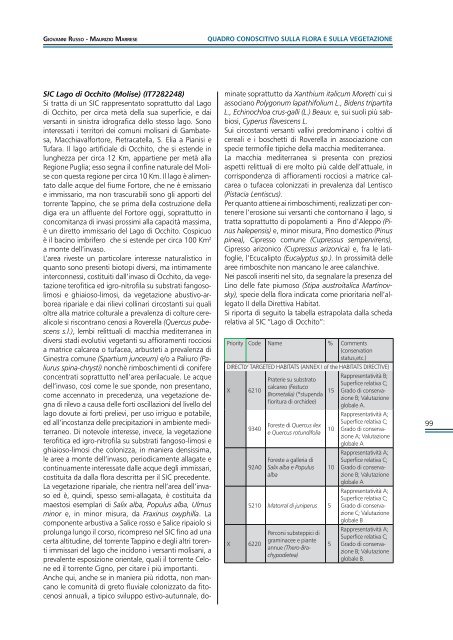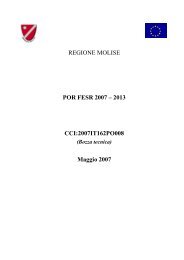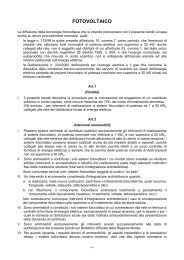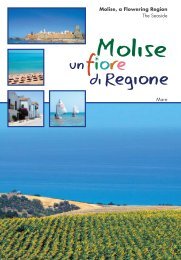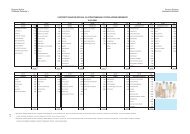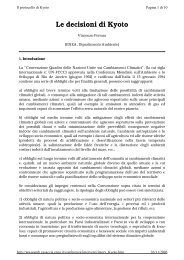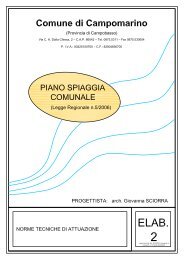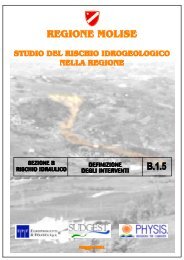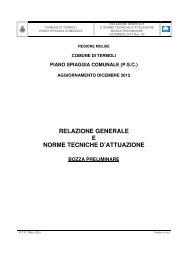Il fiume Fortore - Studi preliminari al piano di gestione dei SIC
Il fiume Fortore - Studi preliminari al piano di gestione dei SIC
Il fiume Fortore - Studi preliminari al piano di gestione dei SIC
You also want an ePaper? Increase the reach of your titles
YUMPU automatically turns print PDFs into web optimized ePapers that Google loves.
Gio v a n n i Ru s s o - Maurizio Marrese<br />
QUADRO CONOSCITIVO SULLA FLORA E SULLA VEGETAZIONE<br />
<strong>SIC</strong> Lago <strong>di</strong> Occhito (Molise) (IT7282248)<br />
Si tratta <strong>di</strong> un <strong>SIC</strong> rappresentato soprattutto d<strong>al</strong> Lago<br />
<strong>di</strong> Occhito, per circa metà della sua superficie, e dai<br />
versanti in sinistra idrografica dello stesso lago. Sono<br />
interessati i territori <strong>dei</strong> comuni molisani <strong>di</strong> Gambatesa,<br />
Macchiav<strong>al</strong>fortore, Pietracatella, S. Elia a Pianisi e<br />
Tufara. <strong>Il</strong> lago artifici<strong>al</strong>e <strong>di</strong> Occhito, che si estende in<br />
lunghezza per circa 12 Km, appartiene per metà <strong>al</strong>la<br />
Regione Puglia; esso segna il confine natur<strong>al</strong>e del Molise<br />
con questa regione per circa 10 Km. <strong>Il</strong> lago è <strong>al</strong>imentato<br />
d<strong>al</strong>le acque del <strong>fiume</strong> <strong>Fortore</strong>, che ne è emissario<br />
e immissario, ma non trascurabili sono gli apporti del<br />
torrente Tappino, che se prima della costruzione della<br />
<strong>di</strong>ga era un affluente del <strong>Fortore</strong> oggi, soprattutto in<br />
concomitanza <strong>di</strong> invasi prossimi <strong>al</strong>la capacità massima,<br />
è un <strong>di</strong>retto immissario del Lago <strong>di</strong> Occhito. Cospicuo<br />
è il bacino imbrifero che si estende per circa 100 Km 2<br />
a monte dell’invaso.<br />
L’area riveste un particolare interesse natur<strong>al</strong>istico in<br />
quanto sono presenti biotopi <strong>di</strong>versi, ma intimamente<br />
interconnessi, costituiti d<strong>al</strong>l’invaso <strong>di</strong> Occhito, da vegetazione<br />
terofitica ed igro-nitrofila su substrati fangosolimosi<br />
e ghiaioso-limosi, da vegetazione abustivo-arborea<br />
ripari<strong>al</strong>e e dai rilievi collinari circostanti sui qu<strong>al</strong>i<br />
oltre <strong>al</strong>la matrice coltur<strong>al</strong>e a prev<strong>al</strong>enza <strong>di</strong> colture cere<strong>al</strong>icole<br />
si riscontrano cenosi a Roverella (Quercus pubescens<br />
s.l.), lembi relittu<strong>al</strong>i <strong>di</strong> macchia me<strong>di</strong>terranea in<br />
<strong>di</strong>versi sta<strong>di</strong> evolutivi vegetanti su affioramenti rocciosi<br />
a matrice c<strong>al</strong>carea o tufacea, arbusteti a prev<strong>al</strong>enza <strong>di</strong><br />
Ginestra comune (Spartium junceum) e/o a P<strong>al</strong>iuro (P<strong>al</strong>iurus<br />
spina-chrysti) nonchè rimboschimenti <strong>di</strong> conifere<br />
concentrati soprattutto nell’area perilacu<strong>al</strong>e. Le acque<br />
dell’invaso, così come le sue sponde, non presentano,<br />
come accennato in precedenza, una vegetazione degna<br />
<strong>di</strong> rilevo a causa delle forti oscillazioni del livello del<br />
lago dovute ai forti prelievi, per uso irriguo e potabile,<br />
ed <strong>al</strong>l’incostanza delle precipitazioni in ambiente me<strong>di</strong>terraneo.<br />
Di notevole interesse, invece, la vegetazione<br />
terofitica ed igro-nitrofila su substrati fangoso-limosi e<br />
ghiaioso-limosi che colonizza, in maniera densissima,<br />
le aree a monte dell’invaso, perio<strong>di</strong>camente <strong>al</strong>lagate e<br />
continuamente interessate d<strong>al</strong>le acque degli immissari,<br />
costituita da d<strong>al</strong>la flora descritta per il <strong>SIC</strong> precedente.<br />
La vegetazione ripari<strong>al</strong>e, che rientra nell’area dell’invaso<br />
ed è, quin<strong>di</strong>, spesso semi-<strong>al</strong>lagata, è costituita da<br />
maestosi esemplari <strong>di</strong> S<strong>al</strong>ix <strong>al</strong>ba, Populus <strong>al</strong>ba, Ulmus<br />
minor e, in minor misura, da Fraxinus oxyphilla. La<br />
componente arbustiva a S<strong>al</strong>ice rosso e S<strong>al</strong>ice ripaiolo si<br />
prolunga lungo il corso, ricompreso nel <strong>SIC</strong> fino ad una<br />
certa <strong>al</strong>titu<strong>di</strong>ne, del torrente Tappino e degli <strong>al</strong>tri torenti<br />
immissari del lago che incidono i versanti molisani, a<br />
prev<strong>al</strong>ente esposizione orient<strong>al</strong>e, qu<strong>al</strong>i il torrente Celone<br />
ed il torrente Cigno, per citare i più importanti.<br />
Anche qui, anche se in maniera più ridotta, non mancano<br />
le comunità <strong>di</strong> greto fluvi<strong>al</strong>e colonizzato da fitocenosi<br />
annu<strong>al</strong>i, a tipico sviluppo estivo-autunn<strong>al</strong>e, dominate<br />
soprattutto da Xanthium it<strong>al</strong>icum Moretti cui si<br />
associano Polygonum lapathifolium L., Bidens tripartita<br />
L., Echinochloa crus-g<strong>al</strong>li (L.) Beauv. e, sui suoli più sabbiosi,<br />
Cyperus flavescens L.<br />
Sui circostanti versanti v<strong>al</strong>livi predominano i coltivi <strong>di</strong><br />
cere<strong>al</strong>i e i boschetti <strong>di</strong> Roverella in associazione con<br />
specie termofile tipiche della macchia me<strong>di</strong>terranea.<br />
La macchia me<strong>di</strong>terranea si presenta con preziosi<br />
aspetti relittu<strong>al</strong>i <strong>di</strong> ere molto più c<strong>al</strong>de dell’attu<strong>al</strong>e, in<br />
corrispondenza <strong>di</strong> affioramenti rocciosi a matrice c<strong>al</strong>carea<br />
o tufacea colonizzati in prev<strong>al</strong>enza d<strong>al</strong> Lentisco<br />
(Pistacia Lentiscus).<br />
Per quanto attiene ai rimboschimenti, re<strong>al</strong>izzati per contenere<br />
l’erosione sui versanti che contornano il lago, si<br />
tratta soprattutto <strong>di</strong> popolamenti a Pino d’Aleppo (Pinus<br />
h<strong>al</strong>epensis) e, minor misura, Pino domestico (Pinus<br />
pinea), Cipresso comune (Cupressus sempervirens),<br />
Cipresso arizonico (Cupressus arizonica) e, fra le latifoglie,<br />
l’Ecuc<strong>al</strong>ipto (Euc<strong>al</strong>yptus sp.). In prossimità delle<br />
aree rimboschite non mancano le aree c<strong>al</strong>anchive.<br />
Nei pascoli inseriti nel sito, da segn<strong>al</strong>are la presenza del<br />
Lino delle fate piumoso (Stipa austroit<strong>al</strong>ica Martinovsky),<br />
specie della flora in<strong>di</strong>cata come prioritaria nell’<strong>al</strong>legato<br />
II della Direttiva Habitat.<br />
Si riporta <strong>di</strong> seguito la tabella estrapolata d<strong>al</strong>la scheda<br />
relativa <strong>al</strong> <strong>SIC</strong> “Lago <strong>di</strong> Occhito”:<br />
Priority Code Name % Comments<br />
(conservation<br />
status,etc.)<br />
DIRECTLY TARGETED HABITATS (ANNEX I of the HABITATS DIRECTIVE)<br />
X 6210<br />
9340<br />
92A0<br />
X 6220<br />
Praterie su substrato<br />
c<strong>al</strong>careo (Festuco<br />
Bromet<strong>al</strong>ia) (*stupenda<br />
fioritura <strong>di</strong> orchidee)<br />
Foreste <strong>di</strong> Quercus iIex<br />
e Quercus rotun<strong>di</strong>folia<br />
Foreste a g<strong>al</strong>leria <strong>di</strong><br />
S<strong>al</strong>ix <strong>al</strong>ba e Populus<br />
<strong>al</strong>ba<br />
5210 Matorr<strong>al</strong> <strong>di</strong> juniperus 5<br />
Percorsi substeppici <strong>di</strong><br />
graminacee e piante<br />
annue (Thero-Brachypo<strong>di</strong>etea)<br />
15<br />
10<br />
10<br />
5<br />
Rappresentatività B;<br />
Superfice relativa C;<br />
Grado <strong>di</strong> conservazione<br />
B; V<strong>al</strong>utazione<br />
glob<strong>al</strong>e A.<br />
Rappresentatività A;<br />
Superfice relativa C;<br />
Grado <strong>di</strong> conservazione<br />
A; V<strong>al</strong>utazione<br />
glob<strong>al</strong>e A<br />
Rappresentatività A;<br />
Superfice relativa C;<br />
Grado <strong>di</strong> conservazione<br />
B; V<strong>al</strong>utazione<br />
glob<strong>al</strong>e A<br />
Rappresentatività A;<br />
Superfice relativa C;<br />
Grado <strong>di</strong> conservazione<br />
C; V<strong>al</strong>utazione<br />
glob<strong>al</strong>e B<br />
Rappresentatività A;<br />
Superfice relativa C;<br />
Grado <strong>di</strong> conservazione<br />
B; V<strong>al</strong>utazione<br />
glob<strong>al</strong>e B.<br />
99


